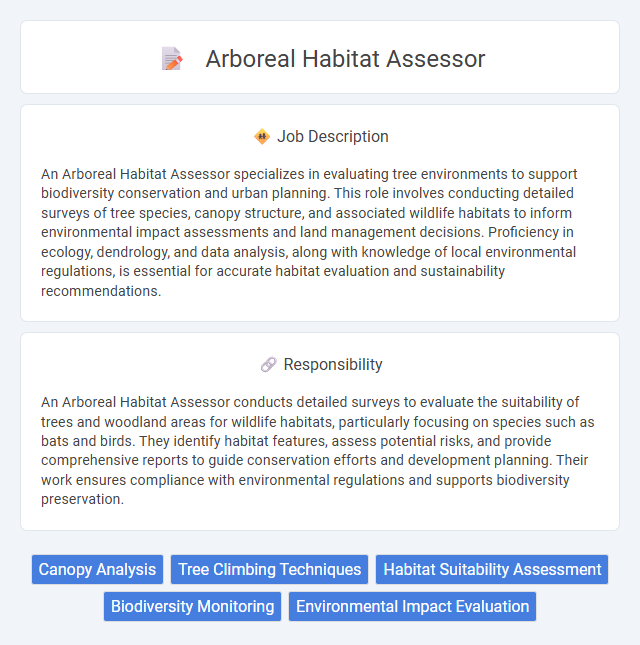
An Arboreal Habitat Assessor specializes in evaluating tree environments to support biodiversity conservation and urban planning. This role involves conducting detailed surveys of tree species, canopy structure, and associated wildlife habitats to inform environmental impact assessments and land management decisions. Proficiency in ecology, dendrology, and data analysis, along with knowledge of local environmental regulations, is essential for accurate habitat evaluation and sustainability recommendations.
People with a strong interest in ecology and comfort working outdoors are likely suitable for an Arboreal Habitat Assessor role, as the job often involves fieldwork and environmental assessments. Individuals with good physical fitness and attention to detail may be better suited to perform accurate habitat evaluations and tree inspections. Those who prefer sedentary or indoor work might find the active, nature-focused duties less compatible with their preferences.
Qualification
A Arboreal Habitat Assessor must possess strong knowledge of tree biology, ecology, and conservation principles, often demonstrated through a degree in environmental science, forestry, or biology. Certification in tree climbing and aerial inspection techniques, along with proficiency in habitat assessment software and GIS tools, is essential. Experience in identifying wildlife habitats within trees, such as bat roosts or bird nests, and a valid climbing safety certificate significantly enhance job performance.
Responsibility
An Arboreal Habitat Assessor conducts detailed surveys to evaluate the suitability of trees and woodland areas for wildlife habitats, particularly focusing on species such as bats and birds. They identify habitat features, assess potential risks, and provide comprehensive reports to guide conservation efforts and development planning. Their work ensures compliance with environmental regulations and supports biodiversity preservation.
Benefit
Working as an Arboreal Habitat Assessor likely offers the benefit of contributing to environmental conservation through the evaluation and preservation of tree habitats. This role probably provides opportunities to develop specialized knowledge in ecology and arboriculture while supporting biodiversity. There is also a chance for professional growth in environmental consultancy and hands-on field experience.
Challenge
The Arboreal Habitat Assessor role likely involves navigating complex and often inaccessible tree canopies, which presents significant physical and logistical challenges. Assessors may face unpredictable environmental conditions that require quick adaptation and specialized knowledge. The job probably demands precise attention to detail to accurately evaluate habitats without disturbing fragile ecosystems.
Career Advancement
The Arboreal Habitat Assessor role offers significant career advancement opportunities through gaining expertise in tree ecology, habitat quality evaluation, and environmental impact assessments. Mastery in using advanced GIS tools and ecological survey techniques positions professionals for leadership roles in conservation projects and environmental consultancy firms. Continuous skill development in biodiversity monitoring and habitat restoration fosters pathways toward senior environmental scientist and project management positions.
Key Terms
Canopy Analysis
The Arboreal Habitat Assessor specializes in canopy analysis to evaluate the health and biodiversity of tree canopies within forest ecosystems. Utilizing advanced tools such as LiDAR and remote sensing technology, the assessor identifies key indicators of habitat quality and structural complexity crucial for arboreal wildlife. Accurate canopy data supports conservation planning and habitat restoration efforts by mapping canopy gaps, leaf area indices, and tree species composition.
Tree Climbing Techniques
Arboreal Habitat Assessors specialize in tree climbing techniques such as single rope technique (SRT) and double rope technique (DRT) to safely access canopy environments for wildlife surveys and habitat evaluations. Mastery of ascending and descending methods, along with efficient use of climbing equipment like harnesses, carabiners, and ascenders, is essential for minimizing environmental impact while conducting detailed observational studies. Expertise in tree climbing allows assessors to gather critical data on arboreal species distribution, health, and biodiversity within forest ecosystems.
Habitat Suitability Assessment
The Arboreal Habitat Assessor specializes in evaluating tree and woodland environments to determine habitat suitability for various species, particularly protected wildlife such as bats and birds. This role involves detailed field surveys, data collection on tree health, canopy structure, and surrounding ecological factors to assess the potential for nesting, roosting, or foraging. Accurate habitat suitability assessments support conservation efforts, inform environmental planning, and ensure compliance with wildlife protection regulations.
Biodiversity Monitoring
The Arboreal Habitat Assessor specializes in biodiversity monitoring by evaluating tree canopies and forest ecosystems to detect species presence and ecological health. Utilizing remote sensing technology, field surveys, and data analysis, they identify habitat quality and biodiversity indicators critical for conservation planning. Their assessments support habitat restoration efforts and inform environmental impact assessments essential for sustainable forestry management.
Environmental Impact Evaluation
The Arboreal Habitat Assessor specializes in evaluating the environmental impact of tree habitats, conducting detailed surveys to identify the presence of protected species such as bats, birds, and invertebrates. This role involves assessing potential risks associated with tree removal or construction projects, ensuring compliance with environmental regulations and conservation laws. Accurate habitat appraisals contribute to sustainable development by informing mitigation strategies that preserve biodiversity and maintain ecosystem integrity.
 kuljobs.com
kuljobs.com